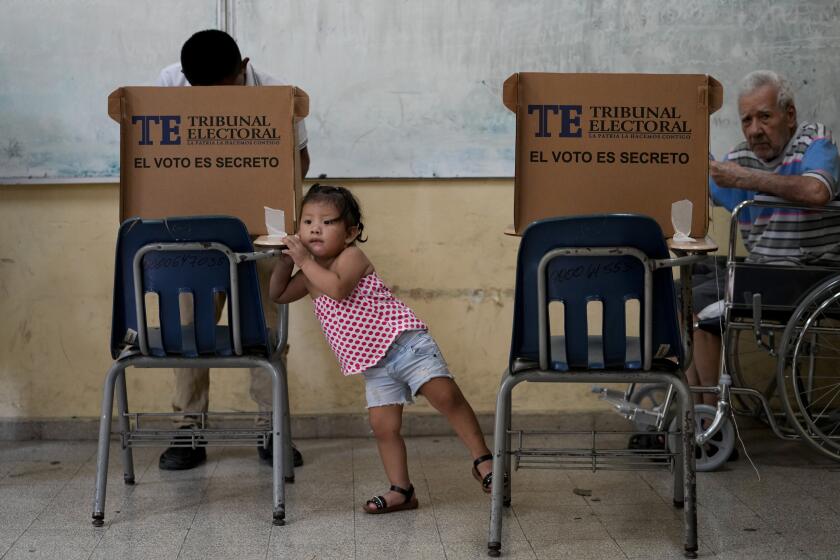Illegal immigrant charged in Chandra Levy case
Nearly eight years after Chandra Levy stepped out of her Dupont Circle apartment on a warm May day and disappeared, District of Columbia police Tuesday charged an illegal immigrant from El Salvador with killing her near a remote hiking trail deep in Rock Creek Park.
Ingmar Guandique, 27, who is serving a 10-year prison sentence for attacking two other women at knifepoint in the park around the time of Levy’s disappearance, was charged with first-degree murder in her 2001 death.
The disappearance of Levy, 24, a federal government intern from Modesto, Calif., triggered an international sensation because she had been having an affair with her congressman, Gary Condit. He fell under suspicion despite a lack of credible evidence implicating him in what would become one of the most infamous unsolved homicide cases in Washington history. He lost his bid for reelection in the March 2002 primary.
D.C. Police Chief Cathy Lanier and Mayor Adrian Fenty said during a news conference that the evidence against Guandique was gathered by a new set of detectives and prosecutors who reinvigorated what had become a cold case. They said the charge was first-degree murder because it was committed during an act of first-degree sexual abuse.
“I now believe we have the person in custody that is responsible for her murder,” Lanier said.
Key among the new evidence outlined in the police affidavit released Tuesday were statements from several unidentified witnesses who said Guandique confessed to them that he attacked, assaulted and killed Levy in the park.
One witness, interviewed late last year, said that he had communicated with Guandique through many letters and that Guandique wrote that he was “responsible for the murder of a young woman.” In a taped telephone conversation with that witness, Guandique confirmed that he had told the witness about the “girl who was dead,” the affidavit states.
Another witness told police last November that he had known Guandique for many years and that Guandique boasted that he was a member of the Salvadoran gang MS-13. Guandique allegedly told the witness that he had attacked and raped many women after lying in wait on a path in the park.
During one of the conversations with that witness, Guandique allegedly said that he and two other men were in the park when they saw a female jogger who “looked Italian with thick, dark hair.” One of the men jumped in front of her, and Guandique grabbed her around the neck and dragged her to a secluded area, he allegedly told the witness; once in the woods, the men knocked the woman unconscious, tied her feet, assaulted her and killed her.
Police also said that during a recent search of Guandique’s cell they found a photograph of Levy, apparently torn from a magazine.
A Washington Post series last summer detailed the police mistakes and miscommunications that led investigators to focus attention and resources on Rep. Condit, who was married. While they investigated the congressman and his romantic links to Levy and other women, Guandique was attacking women in the park not far from where Levy’s body would eventually be found on May 22, 2002.
In an interview last year with the Post from the U.S. Penitentiary-Victorville in Adelanto, Calif., Guandique denied any involvement in Levy’s murder.
“I have nothing to do with the death of that girl. I am innocent, and I am not afraid of the police investigation,” he said.
Guandique, a day laborer, came under the scrutiny of investigators months after Levy disappeared, but a series of delays and missteps allowed the case to languish. Nine months before Levy’s remains were found in Rock Creek Park, an inmate came forward to say Guandique had confessed to the crime while they were in jail, but the inmate’s account was dismissed after he failed an FBI-administered polygraph exam. A polygraph test taken by Guandique before he was sentenced in the two attacks was deemed “inconclusive.” Neither exam was administered by a bilingual polygrapher, even though the inmate and Guandique spoke little or no English. Polygraph results can be skewed if there are translation problems, experts say.
From the time of Guandique’s arrest on July 1, 2001, it took police 13 months to interview his ex-girlfriend, who told the Post that Guandique choked her and bit her around the time of Levy’s disappearance. It took police 14 months to interview his landlord, who said Guandique looked as if he had been in a bad fight around the time Levy vanished. The landlord told police she had thrown out some of Guandique’s belongings that summer. Police also later learned that Guandique did not show up for work the day that Levy disappeared.
With no physical evidence linking Guandique to the crime and few promising leads left, the case went cold.
Last fall, prosecutors began bringing people connected to the case before a grand jury in Washington, and new detectives and a prosecutor assigned to the case interviewed witnesses and examined evidence, including sending some of Guandique’s belongings for DNA testing, sources familiar with the case have said.
The Post investigation published in July found many missteps by the original investigators. Police failed to secure surveillance tapes from Levy’s Dupont Circle apartment, and they had no idea when she left and whether she had left alone or with someone. They corrupted a search of her computer, complicating their own efforts to figure out which websites she visited before she disappeared. Police did not learn for a month that she was looking for information about Rock Creek Park on the day she disappeared.
When police did start to search Rock Creek Park, in July 2001, they botched a search order. The search teams looked 100 yards off the roads in the park instead of 100 yards off the trails. They missed finding Levy’s remains by 79 yards. It would be another year before a man walking his dog found them.
More to Read
Start your day right
Sign up for Essential California for news, features and recommendations from the L.A. Times and beyond in your inbox six days a week.
You may occasionally receive promotional content from the Los Angeles Times.






